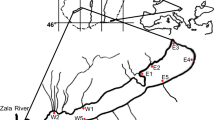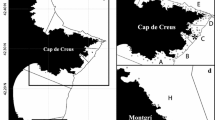Abstract
Participatory turnover time is defined as the time required to cycle an element in a system through a given material in that system. The participatory turnover time of ionic zinc by the adult Meganyctiphanes norvegica population in the Ligurian Sea ranged between 498 and 1243 years, depending upon the available food supply, and considering the food chain as the only route for zinc accumulation by the population. A total-impact turnover time was calculated as the sum of the participatory turnover time for live individuals plus the time required for dead euphausiids to lose 90% of their zinc to the water. Carcasses lost zinc to the water slower than either feces or molts, and so established the maximum loss time for all particulate excretion products; nevertheless, total-impact turnover time for zinc did not differ significantly from the participatory turnover time. The net vertical transport of zinc by M. norvegica from the sea surface to any specified depth can be calculated as the sum of the dissolved zinc excreted below the depth plus the concentrations of zinc left in feces, molts, and carcasses after they have sunk to the specified depth. Carcasses sink the fastest and lose the smallest fraction of their zinc concentration during descent; fecal pellets sink the slowest and lose the greatest fraction of their zinc concentration, and molts are intermediate. Nevertheless, feces represents the major route for delivering zinc to the bottom of the Ligurian Sea (2500 m), because concentration of the element in the pellets is so much higher than in carcasses or molts. Excretion of dissolved zinc into the water at the vertical migration depth of the living population during daylight hours was also inconsequential. Feces zinc represented over 80% of the total zinc transported to the sea floor if only marginal food supplies were available to the euphausiids, and over 90% if food was in sufficient supply. M. norvegica can effect a net transport of about 98% of its body zinc concentration below 500 m daily, in conditions of sufficient food supply and assuming that no released products are eaten during descent. If the food supply in the Ligurian Sea is considered only marginal throughout the year, M. norvegica can still effect a daily net transport below 500 m of about 36% of its body concentration, and about 6% of its body concentration will reach 2500 m daily.
Similar content being viewed by others
Literature Cited
Fowler, S. W. and L. F. Small: Molting of Euphausia pacifica as a possible mechanism for vertical transport of xinc-65 in the sea. Int. J. Oceanol. Limnol. 1, 237–245 (1967).
—: Sinking rates of euphausiid fecal pellets. Limnol. Oceanogr. 17, 293–296 (1972).
— and J. M. Dean: Experimental studies on elimination of zinc-65, cesium-137 and cerium-144 by euphausiids. Mar. Biol. 8, 224–231 (1971a).
— and S. Kěckěs: Effects of temperature and size on molting of euphausiid crustaceans. Mar. Biol. 11, 45–51 (1971b).
Franqueville, C.: Macroplancton profond (invertebres) de la Méditerranée Nord-Occidentale. Thèse de Doctorat de Spécialité, Océanographie biologique, Centre Universitaire de Luminy, Université d'Aix-Marseille 1970.
Ketchum, B. H. and V. T. Bowen: Biological factors determining the distribution of radioisotopes in the sea. In: Proceedings of the Second International Conference on the Peaceful Uses of Atomic Energy, Geneva, 1958. pp 429–433. New York: UN 1958.
Komaki, Y.: Technical notes on keeping euphausiids live in the laboratory, with a review of experimental studies on euphausiids. Inf. Bull. Planktol. Japan 13, 95–105 (1966).
Kuenzler, E. J.: Elimination and transport of cobalt by marine zooplankton. In: Symposium on Radioecology, Proceedings of the Second National Symposium, pp 483–492. Ed. by D. J. Nelson and F. C. Evans. USAEC-CONF-670503 1969.
Lasker, R.: Feeding, growth, respiration and carbon utilization of a euphausiid crustacean. J. Fish. Res. Bd Can. 23, 1291–1317 (1966).
Lowman, F. G., T. R. Rice and F. A. Richards: Accumulation and redistribution of radionuclides by marine organisms. In: Radioactivity in the marine environment, pp 161–199. Washington D.C.: National Academy of Sciences 1971.
Martin, J. H.: The possible transport of trace metals via moulted copepod exoskeletons. Limnol. Oceanogr. 15, 756–761 (1970).
Mauchline, J. and L. R. Fischer: The biology of euphausiids. Adv. mar. Biol. 7, 1–454 (1969).
Osterberg, C. L., A. G. Carey, Jr. and H. Curl, Jr.: Acceleration of sinking rates of radionuclides in the ocean. Nature, Lond. 200, 1276–1277 (1963).
Pearcy, W. G. and C. L. Osterberg: Depth, diel, seasonal and geographic variations in zinc-65 of midwater animals off Oregon. Int. J. Oceanol. Limnol. 1, 103–116 (1967).
Small, L. F., S. W. Fowler and S. Kěckěs: Flux of zine through a macroplanktonic crustacean. In: Symposium on Interaction of Radioactive Contaminants with Constituents of the Marine Environment, Vienna: IAEA (In press).
Smayda, T. J.: Some measurements of the sinking rate of fecal pellets. Limnol. Oceanogr. 14, 621–625 (1969).
Author information
Authors and Affiliations
Additional information
Communicated by J. M. Peres, Marseille
Rights and permissions
About this article
Cite this article
Small, L.F., Fowler, S.W. Turnover and vertical transport of zinc by the euphausiid Meganyctiphanes norvegica in the Ligurian Sea. Marine Biology 18, 284–290 (1973). https://doi.org/10.1007/BF00347790
Accepted:
Issue Date:
DOI: https://doi.org/10.1007/BF00347790




